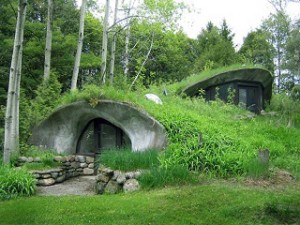From Guest Blogger Emily Folk: What Types of Homes Are Most Energy Efficient?

What about the homes we live in? Could they be designed better, built better so that we use less energy and take better advantage of the energy nature provides us? Here are a few home designs which may greatly decrease our energy consumption.
Prairie Solar Home
A Prairie Solar Home is designed for cold weather environments in order to capture as much available sunlight and heat as possible. These homes have an efficient floor plan and try to minimize the amount of space which needs to be heated. Focus is placed on insulation, energy efficient windows and solar heating. Energy savings can be somewhere around 75 percent.
The kitchen is placed in the spot expected to be the coldest, usually the northeast corner so that the stove and other kitchen appliances can help heat the home. East facing windows capture sunlight and help maintain a comfortable temperature.
The living room is on the western side and is the warmest room in the house. Instead of having a fireplace at the end of a room it is installed in the middle of the home. This helps generate and contain heat throughout the house.
Solar panels heat the water tanks for bathing and washing. Construction materials are used wisely and sparingly to reduce costs without sacrificing quality. House framing is wider and more insulation is used to prevent drafts.
Flooring is made of thick concrete, stone or recycled ceramic tile. A thick floor will insulate and prevent hot or cold air from entering the room. Dark colors are desired as they will also absorb and help maintain the heat.
Modular Homes
Modular homes are built in a factory and later installed on the living site. They are often referred to as “pre fab” or prefabricated homes. They are not the same as mobile homes or manufactured homes which are not placed on permanent foundations.
Modular homes are built faster than traditional homes and are more environmentally friendly as all the construction is done in a factory. This makes them appeal to “green” buyers who want to save money and save future energy costs.
Those who build modular homes speak to their efficient construction. Seventy-seven percent claim waste is reduced at the construction site. Forty-four percent say waste decreased by at least five percent. Depending on the size of the job this could translate into thousands of pounds of less waste going into our landfills.
Modular homes are made to factory specifications, so they are more airtight than homes built onsite. Modular homes are smaller and better insulated, so controlling the temperature is cheaper and more efficient.
Many modular homes are equipped with LED lighting, Energy Star compliant appliances, and sometimes even solar panels. The initial investment means much less energy use throughout the house. The end result is significant cost savings to the homeowner and a well built, comfortable, energy efficient green home for the consumer to live in.
Straw Bale Homes
Homes made of straw weren’t all that uncommon until around the 1940’s. Straw bale construction had a resurgence in the 1990’s as people realized how affordable and how energy efficient they could be.
Straw is a renewable resource. It is grown on farm fields. It doesn’t take decades to grow like traditional lumber and you don’t have to devastate a forest in order to build homes with straw. Straw is light and easy to transport to the construction site. Straw can be produced all over the country, so there is no need for trucks to transport bales hundreds of miles away.
Straw bales make for thick energy efficient walls. Homes made of straw stay warm in the winter and cool I the summer. The insulation potential of straw bales isn’t debatable, but their practicability is. As children, we learned from The Three Little Pigs that the house made of straw was easily blown down the by the Big Bad Wolf.
There is debate whether straw is more or less flammable than other building materials. Straw is not widely accepted as a home building material and may not conform to local construction codes. Straw can be a natural host to bugs and mold if builders don’t use caution.
You can’t drive nails into a bale of stray if you are trying to hang something on your walls. As with many other options, you have to be willing to give something up in order to gain another advantage. It comes down to personal choice.
Better planning, better designing and efficient living spaces are what will power our energy consumption. Recycled materials, preformed, lightweight, energy efficient building blocks and an emphasis on insulation will help us get the most from our heating and cooling. Making changes to the designs of our homes and to the types of energy we use will ensure greater access to longer lasting renewable resources.
